A very important part of any trip around the world for me is discovering new foods and getting a glimpse of local traditions. My family discuss the country, what they eat, how they eat. Who their neighbours are, where is the country, what continent. It's a great way to discover the world, even though we don't really go there.
I always find it interesting trying food from countries I know nothing about, with Poland however, I had an idea that some of their dishes would be similar to those that I grew up on. I had a feeling Croatian and the Polish would eat similar food, and I was right.
This was an easy country to get through, their was a lot of recipes I could find and it was an easy one in terms of cooking as not only are the flavours similar to Croatian, so was the cooking methods.
The food I have tried has been delicious and my family have loved our visit to Poland.
Two sites I liked the most were the Polish Housewife and Polish Your Kitchen.
If the recipe is not written down below, click on the name of the recipe, it is a link that will take you to the recipe.
Kapusta Kiszona-Homemade Sauerkraut
Sauerkraut and Mushroom Pierogi
Potato and Cheese Pierogi
Haluski-Fried Cabbage and Noodles
Golonka w Kapuscie-Fresh Pork Hocks with Sauerkraut
Barszcz-Beetroot Soup
Rosol-Polish Chicken Soup
Kartoflanka-Potato Soup
Polish Meat Patties-(Kotlety Mielone)
Krokiety-Polish Filled Crepes
Golabki-Polish Mince Stuffed Cabbage
Bigos (Hunters Stew)
Kielbasa Sausage with Braised Sauerkraut (Quick Bigos)
Polish Cabbage and Sauerkraut Soup (Kapusniak)
Polish Goulash with Mushrooms
Polish Spare Ribs with Sauerkraut-Zeberka w Kiszonej Kapuscie
Kotlety Schabowy-Crumbed Pork
Miseria-Cucumber Salad
Jarzynowa-Potato Salad
Szarlotka-Apple Pie
Nalesniki-Crepes
Faworki-Polish Angel Wings
Knedle ze Sliwkami-Polish Potato Dumplings with Plums
Placek z Sliwkami-Polish Plum Cake
Kompot-Polish Dried Fruit Compote
There are still a few recipes I will try from Poland, I'll add them as I make them.
2 eggs
3 apples
1/2 teaspoon cinnamon
1.5 cups of flour
1 cup of milk
1/2 teaspoon vanilla extract
2 tablespoons of powdered sugar
1/2 tablespoon of baking powder
oil to fry (about 5 tablespoons)
Warm the milk slightly, then beat it together with eggs and vanilla.
Add flour, sugar and baking powder to the mix. Mix together until smooth (mixer is recommended for this step).
Meanwhile, peel and grate apples, sprinkle with the cinnamon. Add to the mix and stir with a spoon.
Heat up the oil on a frying pan and using a spoon or medium-size spatula put pancakes on the frying pan (about 4 per frying pan).
Fry for 2-3 minutes until brown, then flip.
Serve with powdered sugar on top.
Enjoy!
1 large pinch of salt, about 1 teaspoon
1 egg
1 cup (250ml) of warm water
Combine the flour, salt and egg in a bowl of a free standing mixer. Turn mixer on low and start adding the water in slowly, keep adding water until a dough forms. You may not need all the water. On the other hand if your dough looks dry, add a little more water. You want a dough that is soft, but not sticky. Allow the dough to knead for about 5 minutes in your mixer. Leave your dough to rest, covered with cling film, for about 30 minutes. Place the dough on a floured board. Divide your dough into three pieces. Roll out in batches into about 2 millimetres in thickness, add flour if the dough is sticky. With a glass rim or cookie cutter, cut out circles.
(there is a video link below on how to make them)
Now they are ready to fill, there are two fillings below.
You can serve immediately garnished with sautéed onion and bacon bits or sauté in butter on both sides until golden brown, garnished also with onion and bacon bits. Bacon bits are optional, but very desirable, actually I find it essential.
1 tablespoon vegetable oil
55g butter
1 large onion, finely diced
450g fresh mushrooms, chopped
1 teaspoon salt
¾ teaspoon pepper
¼ cup sour cream
Garnish
4 rashers bacon, diced
1 onion, diced
60g butter
To serve:
Sour cream
Chopped chives
Make pierogi dough as per recipe above.
Rinse sauerkraut with cold water and squeeze out as much water as possible. Chop into small pieces.
Heat butter and oil in large frying pan until butter melts. Add onions and cook over moderate heat until onions are softened.
Add mushrooms and turn the heat up to medium-high. Continue to cook until the liquid from mushrooms has evaporated and the mushrooms become evenly browned. Stir frequently and monitor the heat to prevent burning.
Add sauerkraut, salt, and pepper to pan. Continue to cook and stir until heated through.
Turn off heat and add sour cream. Mix well and place filling in container and cover. Refrigerate until cool.
Roll out your pierogi. Place a generous amount of filling in each circle, just make sure you can seal them, and seal tightly. Wet the inside of the edge for a better seal, and press edges with a fork once sealed or create a decorative edge.
Fill a large pot with water, add a tablespoon each of salt and oil. Once water starts boiling, turn down to low. Place a few dumplings (about 10, not to overcrowd) into boiling water, and lightly stir, to prevent sticking. Let boil for about 3 minutes, until they all float up to the top. Take out and spread on a clean surface, not touching.
Make the Topping/Garnish: Saute bacon and onion in butter, until the onion has softened and the bacon is cooked.
As soon as you add the pierogi to the water, in a large frying pan, add about 50g butter. Once the pierogi are cooked, add as many as can fit in the pan in a single layer, the ones that don't fit, I just leave unfried, as they are great like that to. Fry until lightly coloured on both sides, add to the the other cooked pierogi. Repeat with second batch of pierogi.
Drizzle the pierogi with melted butter and bacon topping. Serve with sour cream and chopped chives.
Enjoy!
900g potatoes
450g of farmer's cheese (or 450g cottage cheese-drained + 3-4 tbsp of plain greek yogurt)
1 large onion
30g butter
1 teaspoon of salt
1 teaspoon of freshly ground pepper
Garnish
4 rashers bacon, diced
1 onion, diced
60g butter
To serve:
Sour cream
Chopped chives
Make pierogi dough as per recipe above.
To make the filling, peel and boil potatoes in salted water until soft. Drain and set aside to cool.
Mince the onion and sauté in butter until golden brown.
If using farmer's cheese, crumble with a fork and set aside. If using cottage cheese, place in a strainer to strain some of the liquid.
When potatoes cool, mash with a hand masher, add sautéed onion, cheese (if using cottage cheese, add plain greek yogurt), salt and pepper. Mix until combined. Taste and add salt, if needed.
Roll out your pierogi. Place a generous amount of filling in each circle, just make sure you can seal them, and seal tightly. Wet the inside of the edge for a better seal, and press edges with a fork once sealed or create a decorative edge.
Fill a large pot with water, add a tablespoon each of salt and oil. Once water starts boiling, turn down to low. Place a few dumplings (about 10, not to overcrowd) into boiling water, and lightly stir, to prevent sticking. Let boil for about 3 minutes, until they all float up to the top. Take out and spread on a clean surface, not touching.
Make the Topping/Garnish: Saute bacon and onion in butter, until the onion has softened and the bacon is cooked.
As soon as you add the pierogi to the water, in a large frying pan, add about 50g butter. Once the pierogi are cooked, add as many as can fit in the pan in a single layer, the ones that don't fit, I just leave unfried, as they are great like that to. Fry until lightly coloured on both sides, add to the the other cooked pierogi. Repeat with second batch of pierogi.
Drizzle the pierogi with melted butter and bacon topping. Serve with sour cream and chopped chives.
Enjoy!
120g streaky bacon or 60g pancetta, diced
90g unsalted butter, divided into thirds
2 brown onions, diced
700g green cabbage, coarsely shredded
1 teaspoon salt
1/2 teaspoon white pepper
170g dry pasta
In a medium pot, cook bacon (or pancetta) to crisp over medium heat.
Remove bacon (or pancetta) and leave one tablespoon of the bacon fat in the pan. Discard the rest.
Keep heat on medium and add 1/3 of butter and the onions and cook two minutes.
Add another third of the butter, the cabbage, salt, and pepper and cook, stirring for about 5 minutes. Now add the bacon, stir, cover, and cook for about ten minutes on medium low, stirring occasionally or until cabbage is tender.
While cabbage is cooking, cook pasta as per packet instructions.
Once the cabbage is tender, add drained cooked pasta along with the remaining two tablespoons of butter.
Heat to serving temperature, taste for additional salt and pepper and serve.
This dish traditionally is served heavy on black pepper, but we will leave it up to your tastes.
Enjoy!
4 pork hocks (about 1.4 kg)
salt and pepper
2 carrots
1 parsnip
1 stick celery
1 small onion, quartered and burnt on a dry pan
3 garlic cloves
6 black peppercorns
l allspice seeds
1 kg of sauerkraut
1/2 tsp of caraway seed
Wash and pat dry pork hocks. Make sure they've been de-haired, if not, burn off the hair first. Sprinkle with salt and pepper and place in the fridge overnight.
When ready to cook, place pork hocks in a stock pot and fill with enough water to cover. Add peeled carrots, parsnip, celery root, burnt onion, crushed garlic cloves, peppercorns and allspice. Bring to boil, turn heat down and simmer on low for about 1.5 hours.
In the meantime, rinse sauerkraut and let drain, squeeze access water. Place half of sauerkraut in a large baking dish and sprinkle with caraway seed. Set aside.
Preheat oven to 150C/130C fan forced.
After 1.5 hours of cooking pork hocks, take them out, place on sauerkraut and place the rest of the sauerkraut around it. Strain liquid from cooking. Taste it. Add a bit salt and pepper, if not salty enough. Pour 2 cups/500 ml of liquid onto your dish. Bake for 1 hour but do move sauerkraut and meat around occasionally to prevent burning.
After 1 hour, turn up to 190C/170C fan forced and roast for another 15 min. At the end of cooking, meat should be coming off the bone.
Enjoy!
4 large or 6 small beetroots, peeled and halved
500g meaty beef bones
200g beef spare ribs
1 medium carrot, peeled
1 medium parsnip, peeled
1 large onion, peeled and halved
1 leek, white and green parts, trimmed, halved lengthwise and rinsed
1 long celery stalk
3–4 dried porcini mushrooms
8 cloves garlic, peeled but left whole
1 bay leaf
1 large pinch of dried marjoram
6 peppercorns
1 teaspoon vegeta, to taste
About 12 cups of water, depends on the size of your pot
Juice of 1 lemon, or about 4 tablespoons
Salt and pepper, to taste
Add the beetroot, beef bones, carrot, parsnip, onion, leek, celery, mushrooms, garlic, bay leaf, marjoram, peppercorns and vegeta to a Dutch oven or stockpot.
Add enough water to the pot to cover the ingredients. Bring to a boil, reduce heat and simmer for about two hours. Skim off foam as it appears.
Strain the soup through a colander. If it tastes watery/light and you want a deeper flavour, cook it down a bit more to concentrate the flavours.
Add lemon juice and season to taste with salt and pepper, it should taste garlicky and tart.
Serve the clear, hot soup in bowls or cups for sipping
Enjoy!
1.5kg chicken (you might go with pieces rather than whole, but you want the bone in)
600g beef bones
3 turkey necks, if you can find them, substitute with 600g chicken necks or even better chicken feet)
2 large onions, peeled, halved
5 carrots, trimmed and peeled
2 parsnips, trimmed and peeled
1 leek, trimmed, use the white and light green part
3 stalks celery
1/4 small savoy cabbage
1 whole clove
4 allspice berries
2 bay leaves
4 sprigs fresh flat leaf parsley
1 teaspoon whole black peppercorns
1/2 tablespoon salt (adjust amount to taste)
1/2 tablespoon vegeta, optional
thin noodles, to serve
Add chicken, beef bone, and turkey necks to a large stock pot. Cover with water.
Bring to a boil and simmer for 2 to 2 1/2 hours, skimming any impurities off the top to insure a clear broth
If your pot is big enough, add the vegetables and spices for the last hour of the cooking time. If it isn't big enough to hold everything, cooked the meat/bones for the full cooking time, then removed them, and cooked the vegetables and spices in the broth for a further one hour. Strain everything out of the broth.
Bone the chicken, pulling the meat into large chunks. Slice the carrots.
Return the chicken and carrots to the broth.
Cook noodles according to package instructions if you’re using them. Add noodles to bowl and then top with hot soup (I just cooked the pasta in the soup, but you can cook it separately).
Enjoy!
(My crepe recipe makes 10 crepes, so I make double the amount of crepes as the extras become dessert with nutella or jam. If new to crepe making make two batches of the crepe batter so you learn the consistency you need, if experienced, you know how to make crepes
160g plain flour
2 eggs, lightly beaten
500ml milk
Canola cooking spray
For the filling:
1 tablespoon butter
225g mushrooms, diced
1 small onion, diced
1/2 cup sauerkraut, drained
1/2 cup meat of your choice
1/2 cup grated cheese or white sauce (bechamel)-just enough to bind ingredients together, I just use cheese as it's easier
Mushroom Sauce:
60g unsalted butter
600g swiss brown mushrooms, sliced
3-4 garlic cloves, finely chopped
200g enoki mushrooms, ends trimmed
1/3 cup dry white wine
3/4 cup chicken or vegetable stock
450ml thickened cream
2/3 cup parmesan, finely grated
2 tablespoons chives, chopped
to assemble:
1 egg
1 tablespoon water
1 cup breadcrumbs
sunflower oil, for frying
Make the pancakes: Place the eggs in a mixing bowl, add the flour. Add half of the milk; using a whisk, whisk until your mixture is lump free. Keep adding milk slowly until all the lumps have disappeared, then add remainder of milk, mix through. It is easier to get the lumps out, if the mixture is thick, so don't add all the milk in straight away. Leave to stand for 30 minutes. Strain the mix through a sieve to make them completely lump free-I however never do, more cleaning up, and a few tiny lumps don't make a difference, well, not for me at least.
Heat a 20cm non stick crepe pan (or frying pan) over medium-high heat. Spray the pan lightly with cooking spray. Using a ladle, pour 1/2-3/4 of a ladle full into the top edge of the pan, quickly tilt your pan around so the batter covers the entire pan. Keep swirling it around until the mixture stops running. Cook for 30 seconds to 1 minute. The sides of the crepe will start to colour and will lift away from the side of the pan so you can slide a long plastic icing spatula under the centre of crepe, that will help you flip the crepe. The crepe should be lightly coloured. Cook for a further 30 seconds, until lightly coloured. Repeat with oil spray and remaining batter.
Add butter, chopped mushrooms and onion to a frying pan and cook until tender.
Add sauerkraut (I snipped the sauerkraut with scissors, it seemed easier than dicing) and cooked meat
Add grated cheese (or white sauce) and stir to combine. Set aside.
Put approximately 2 tablespoons of filling on a crepe, if the crepe were a clock, position the filling between 10 and 2 o’clock, keeping it about an inch from the edges, fold the top over the filling and fold the sides in and continue rolling. Repeat until you run out of crepes or filling.
Mushroom Sauce: In a frying pan, add butter over a high heat. Add mushrooms and cook for 4 minutes, until starting to turn golden brown on the edges.
Reduce heat to medium then add garlic and the enoki mushrooms and a pinch of salt and pepper, and continue cooking for another minute until both garlic and mushrooms are golden.
Add the white wine, cook for 30 seconds to a minute, scraping the bottom of the pan, until wine is mostly evaporated and the alcohol smell is gone.
Add the chicken stock, cook vigorously for 1 minute so it mostly evaporates. Then add cream, lower heat to medium and simmer for 2 minutes until it reduces and thickens slightly.
Stir in parmesan, taste and add more salt and pepper if needed.
Crumb the krokiety:
Whisk egg and water together well.
Carefully dip rolled crepes in the egg wash and them roll in breadcrumbs.
Heat oil, about 1cm deep, to 175C over high to medium high heat. Carefully place krokiety in hot oil, cooking until golden brown, about one minute on each side.
Serve along side Barszcz or with mushroom sauce.
Enjoy!
2 1/2 cup of cooked rice
2 medium onions
25g of butter
1 head of cabbage
250g of minced beef
250g of minced pork
1 teaspoon of salt
1/2 teaspoon of pepper
1 litre of chicken or vegetable stock
3 bay leaves
Tomato sauce:
2 x 410ml cans of diced tomatoes
1/3-1/2 cup of tomato paste
750ml of chicken or vegetable stock
1/2-1 teaspoon of salt, to taste
White pepper, to taste
2 bay leaves
5 whole peppercorns
3 all-spice berries
Cook rice following the directions on the package, but shorten the cooking time by half.
Wash cabbage and cut out the core.
Place cabbage in a pot (core down) and fill with water to cover the whole head. Start heating the water and as the leaves start loosening away from the head, remove from water (careful! Hot!). Set leaves aside, and also preserve those that may break while separating.
Lay out cooled leaves and with a sharp knife, slice off a portion of the thick part of the spine so the leaves lay flat (there may be a slight curve in the leaf). Watch the video if you are unsure how to do this.
Sauté the onion in the butter until has softened. Allow to cool.
Place ground meat in a large mixing bowl, add cooked rice, sautéed onion, salt, pepper. Hand mix until combined.
Depending on the size of the cabbage leaves, place a ball of meat on each leaf in the natural curve of the leaf. Start rolling from the bottom, then sides. Set rolls aside until all done.
Now to cook, you may choose to bake or boil. I baked mine, but I'll give you both cooking methods.
To bake:
Place a layer of cabbage leaves (4-5 of the large tougher outer leaves that have holes in them) in the base of your baking dish. Your dish needs to be big enough to fit all your rolls in one layer.
Place rolls in a baking dish. Carefully add the chicken stock (so that the stock comes up about 1/3-1/2 way up the cabbage rolls). Now cover with more of the broken up outer leaves. Bake at 180°C/160°C fan forced for about 45 minutes to 1 hour.
To boil:
Place broken leaves on the bottom of the pot you boiled the cabbage in and layer cabbage rolls on top, placing each roll seam down. Cover with any leftover leaves.
Fill the pot with chicken stock to cover the layered rolls. Boil on low for about 30 minutes.
Meanwhile make your tomato sauce:
In a blender add diced tomatoes with tomato paste and salt, blitz until smooth. Season with a little white pepper. Transfer to a medium saucepan, add the stock and spices and simmer on medium-low for about 15-20 minutes, or until thickened to your liking.
Serve golabki with the sauce on mashed potatoes.
Enjoy!
40g butter
2 large brown onions, diced
3 apples, hard & sweet, I used pink lady, peeled, quartered, core removed
450-500g kiełbasa sausage, sliced into 1cm rounds
200g strongly smoked kiełbasa sausage, sliced into 1cm rounds
100g bacon, sliced
2 x 800g jars sauerkraut
4 bay leaves
5 allspice berries
5 juniper berries
Black pepper, freshly ground
Salt, for seasoning
1 litre chicken stock
Have a little taste of the sauerkraut. If it’s too sour, use a colander and rinse it in cold water, then drain it.
Roughly chop the sauerkraut, pieces shouldn’t be longer than 2.5cm.
It’s best to use a dutch oven. Alternatively, fry everything on a regular frying pan and then move it into an oven-friendly dish.
Set up your oven to 180°C/160°C fan forced.
Heat up butter in your Dutch oven. Add onion, season it lightly with salt, cook for a minute on medium heat, stirring from time to time.
Add in sausage and bacon slices. Fry for 2 to 3 minutes, stirring regularly, as the onions start to brown. Take it off the heat.
Add chopped sauerkraut, spices bay leaves, allspice berries, juniper berries) and apples.
Generously season with freshly ground black pepper and optionally with salt as well (careful though - sauerkraut, kiełbasa and bacon are very salty already).
Pour in the chicken stock, enough to cover the sauerkraut. Cover the dish with a lid.
Place the dish in the oven for 90 minutes. After that time take the dish out and stir well. If it’s too dry, add some more stock (or water).
Cover again and return to the oven for another 90 minutes.
Serve warm with some bread or potatoes on the side.
Enjoy!
4 slices coarsely chopped streaky bacon
1 large onion, diced
2 stalks celery, thinly sliced
4 medium carrots, thinly sliced
2 large potatoes, peeled and cut into 1½cm dice
2 cloves garlic, finely chopped
1 small head savoy cabbage, coarsely shredded
900g unsmoked pork spareribs, cut into 2-rib pieces
1 ham hock
500g sauerkraut, drained, juice reserved
240ml tomato passata
4 litres beef stock
1 teaspoon sweet Hungarian paprika
1 bay leaf
2 tablespoons sugar
1 tablespoon finely chopped fresh parsley, for garnish
Sour cream, for garnish, optional
In a large Dutch oven or stockpot, sear pork ribs on both sides over medium-high heat. There should be enough fat on the ribs so additional fat should not be required. If the ribs are very lean, lightly spray the pot with cooking spray before searing. Remove browned ribs to a plate and reserve.
Add bacon to the pot and fry until most of the fat has rendered out. Add onions, celery, carrots, potatoes, and garlic to the pot and cook until onion is translucent. Add fresh cabbage and cook until it collapses. Return spareribs to the pot and add ham hock, sauerkraut, tomato passata, beef stock, paprika, bay leaf, and sugar. Mix well. Bring to a boil. Reduce heat to medium-low and cook about 2 hours or until meat falls from the bones.
Remove ribs and ham hock from the soup, let cool slightly and remove all bones and cartilage from meat. Chop meat into bite-sized pieces, if necessary, and return to the pot. If you prefer a slightly more sour soup, add some of the reserved sauerkraut juice.
Serve with a dollop of sour cream, optional, and sprinkle with chopped parsley, if desired.
Enjoy!
900g-1kg pork shoulder, diced, bite sized
1 medium yellow onion, peeled, diced
2 garlic cloves, peeled, chopped
2 tablespoons sunflower oil
2 pinches of salt, to taste
2 pinches ground white pepper, to taste
200g, smoked bacon, cut into lardons
3 all-spice berries
2 bay leaves
1 teaspoon smoked paprika powder
½ teaspoon spicy paprika powder, or chili powder
½ teaspoon dried marjoram
2 cups (500ml) beer (ale, lager, hard cider)
1 cup (250ml) chicken or vegetable stock, low sodium
1-2 carrots, peeled, sliced into rounds or half circles
200g fresh wild mushrooms, sliced, mix it up, what you can find
3 tablespoons tomato paste
1 tablespoon butter
2 tablespoons plain flour
Preheat oven to 160C/140C fan forced. You can cook it on the stove top, i prefer the oven.
Add oil into a deep cast iron ovenproof pot, over a medium heat. Add onions and fry for 5-7 minutes until it turns translucent, stirring from time to time.
Add in the garlic and the meat, season it generously with salt and pepper. Fry on a high heat until every piece is nicely browned. Remove from the pot, set aside.
Add the bacon to the pot, add a little more oil, if needed. Add in all-spice berries, bay leaves, smoked paprika, spicy paprika and dried marjoram. Fry for a few minutes, stirring continuously, until bacon renders some of its fat and starts to turn golden.
Pour in the beer, turn up the heat and bring it to a near-boil, scrape the base of your pot to remove any stuck on bits. Return the pork and onion mix to the pot. Pour the chicken stock in and cover the dish with a lid. Cook on the stove for 1.5 hours on a medium-low, or place it in your preheated oven.
When the time is up, take the casserole dish out of the oven and carefully remove the lid. Add in the carrots, sliced mushrooms, tomato concentrate and butter. Stir everything together, cover the dish with the lid and return it into the oven (or place back on the stove). Continue cooking/baking for an additional hour, until the meat turns tender.
To thicken the goulash, mix the flour with a tablespoon or two of water, to form a thin paste, removing any lumps of flour, then add it to the casserole dish, stir it in and bring to boil, on the stove top.
.
Before serving, taste for seasoning. Serve hot with sides of your choice.
Enjoy!
With the sauerkraut, if you are using store bought sauerkraut, buy whole heads or jars with whole leaves and shred them yourself, I find pre shredded sauerkraut is shredded too finely. And taste the sauerkraut raw, if it is too sour, rinse it under cold water.
700g of pork spare ribs with bones, sliced into 2-3cm slices
Salt and pepper
170g of thick cut smoked bacon, cut into lardons
2 small onions, diced
3 cloves garlic, finely chopped
1 large carrot, cut into large dice
3 tablespoons sunflower oil
3 tablespoons plain flour
2 cups (500ml) chicken or vegetable stock
about 1 kg of sauerkraut, homemade or store bought
1/2 teaspoon of dried thyme
5-6 allspice, whole
6 black peppercorns, whole
3 bay leaves
Wash and dry ribs. Cut into 1 bone sections, about 2cm thick. Sprinkle with salt and pepper and set aside. In the meantime, cut bacon into cubes, chop onion and peel and mince garlic.
Heat oven to 180°C./160C fan forced.
In a large cast iron ovenproof pot heat oil over medium-high heat. Add ribs and cook until golden brown on both sides (about 6-8 minutes per side), remove from heat and set aside. Into the same pan add bacon, onion, garlic and carrot, sauté for about 4-5 minutes. When onion and bacon are golden brown add flour and chicken or vegetable stock. Whisk to combine. Add sauerkraut, thyme, allspice, peppercorns and bay leaves. Mix well and heat through.
Return pork to the pot, push it into the middle of the sauerkraut, so it is covered by the sauerkraut. If you don't have an ovenproof pot just use a large baking dish and place half of the sauerkraut mixture, then a layer of ribs and then again sauerkraut.
Bake covered for 2 hours. Check after about 1.5 hours of cooking to make sure there is a bit of moisture left, if not, add a 1/4-1/3 of a cup of water or stock.
Serve with bread, boiled potatoes, or polenta.
Enjoy!
4 pieces thinly sliced pork neck or pork fillets
Salt and pepper, to taste
2 cups plain flour
1 large egg
1 teaspoon water, to beat with large egg
2 cups breadcrumbs, or panko breadcrumbs
1-2 cups vegetable or sunflower oil
Pound pork between 2 pieces of plastic wrap to 6mm in thickness. Season both sides with salt and pepper.
Dredge cutlets in flour, then the well beaten egg-water mixture, then breadcrumbs or panko breadcrumbs.
Heat oil in a large frying pan over medium-high heat, you want the oil to come up half way up the schnitzel when they are added. When the oil is hot add the pork schnitzels and fry until golden brown, then flip over and repeat with the other side, it will probably take about 4-5 minutes per side, it will depend on the thickness of your pork.
Serve hot. I served it with the cucumber salad and a potato salad..
Enjoy!
2 English cucumbers
1/2 teaspoon salt, to taste
1/2-2/3 cup sour cream, to taste
1/2 teaspoon caster sugar, to taste
1 tablespoon fresh dill
1-2 tablespoons lemon juice
white pepper, to taste
Wash and peel (optional to peel, I leave it sometimes) the cucumber. Slice thin. Add salt and let sit for 10 minutes.
After 10 min, drain any water that may have accumulated.
Add sour cream and dill, lemon juice and sugar, season with pepper, to taste. Mix and chill until ready to serve.
Enjoy!
4 medium salad potatoes, unpeeled
2 medium carrots, peeled
4 eggs, hard boiled
6 small pickled gherkins, finely chopped
2 apples
5 tablespoons thick yogurt
5 tablespoons mayonnaise
1 tablespoon mustard
Fine sea salt and pepper to taste
Place the potatoes in a pot of cold salted water, bring to the boil. Then simmer until tender (don't overcook them!). Drain and set aside to cool, then peel and chop the potato into small cubes and place in a large bowl.
Place the carrots in a pot of cold salted water, bring to the boil. Then simmer until tender (don't overcook them!). Drain and set aside to cool, then peel and chop the carrot into small cubes and place in the bowl.
Place the eggs in a pot of cold water, bring to a simmer, simmer for 6-8 minutes. Drain and set aside to cool, then peel and chop the egg into small cubes and place in the bowl.
Finely chop the gherkins and add into the bowl.
Peel and core the apples, cut into quarters and finely chop. Combine with the salad.
Add the yogurt, mayonnaise, mustard and seasoning to the mixture and stir carefully but thoroughly. Refrigerate, covered, for up to 2 days. It needs at least 2 hours in the fridge, before serving.
Enjoy!
1 1/3 cup (165g) flour
2 large egg yolks
1/4 cup (60g) sour cream
1 tablespoon icing sugar
1 teaspoon vanilla extract
2 teaspoons vodka or rum
2 teaspoons grated lemon zest or orange zest
1/4 teaspoon salt
3-4 cups sunflower oil, for frying
caster or icing sugar, for dusting
Make the dough: Whisk the egg yolks with vanilla and sour cream, add all the other ingredients, and knead a smooth dough. It will take about 7 minutes with a stand mixer (fitted with a dough hook attachment) or about 12 minutes by hand. The dough should be very smooth.
'Beat' the dough: Roll out the dough slightly (into roughly a 20cm round/square), fold in half, then fold in half again. Repeat it 4 times or more (the more the better). Beat the dough with the rolling pin while you try to roll it out – this will make these crunchy air bubbles on the faworki. You can roll it out with a pasta machine, I usually don't do that – you should beat it with a rolling pin as much as you can. Note: beating the dough is not completely necessary but it will result in a very crispy, delicate dough.
Let it rest: Wrap the dough in plastic foil and leave to rest for 20 minutes (it will be easier to roll out).
Roll out the dough: On a lightly floured surface, roll out the dough as thinly as you can (you should see through the dough). I love to use a silicone rolling mat for rolling out any dough. The dough will be rather tough to roll out.
Cut and shape the faworki: Cut the dough into 4cm wide strips (you can use a ravioli cutter wheel or pizza knife). Cut each strip into 13cm long slices (you can cut them parallel to the previous cuts or at an angle, like on the photos). Cut a small slit in the middle of each strip. Twist and pull one end through the slit. Cover the dough with a kitchen towel so it won't dry out.
Fry the dough: Heat 3-4 cups of frying oil to 180°C in a shallow pot or a frying pan. You should have about 5cm of oil in the pot. Fry the faworki in batches until golden on both sides (using two forks, turn them on the other side). Don't go away from the pot, they cook fast – about 1-2 minutes per batch. Don't add too many at once or the temperature of the oil will drop too much and they will soak up the fat. The temperature of the oil should always be between 175°C-185°C – it's best to check it with a candy/grill thermometer.
Dust with icing or powdered sugar: Transfer each batch of faworki to a plate lined with paper towels to drain excess fat. When they are cool enough to handle, transfer them to a second plate and dust them generously with powdered sugar (they should be dusted in sugar while still warm).
Enjoy!
1kg potatoes
300g plain flour
50g butter or margarine
1 egg
300g sugar plums (the little ones), halved
Caster sugar, for filling
100g breadcrumbs
75-100g butter
caster sugar, for sprinkling
Place potatoes in cold water, bring to the boil, simmer about 30 minutes or until cooked through. Drain.
In the meantime make your breadcrumb coating. In a large frying pan, add the butter, I start with 75g then add more if needed, once melted over a medium heat, add the breadcrumbs, stir into the butter and toast gently, if the mixture feels too dry, add more butter, but you don't want an oily mess.
Once cool enough to handle peel and mash.
To the warm potato add the flour, butter or margarine and egg, mix together with a spoon, then knead for a minute or two. If the dough is sticky, add more flour, but only if you need to.
Bring a large saucepan of water, to the boil.
Dust hands with flour, grab a bit of the dough, enough to wrap around half a plum, flatten it out in the palm of your hands. Place a half plum, cut side up in the centre of your dough, add some caster sugar in the centre of your plum, to taste, gently wrap the plum with the dough, rolling to ensure there are no gaps. Place on some baking paper, while you make 5 more. When you have made 6, gently pick them up off the baking paper and re shape if the base is flat, and using a spoon dipped in the boiling water, gently place the dumplings in the boiling water. Cook for 10 minutes. In the meantime, make another 6 dumplings.
When the first batch is cooked, gently lift out of the water, drain well, and roll them in your breadcrumb mix. Place on a serving plate.
Repeat the cooking process and the rolling process until all the dumplings are made.
Sprinkle all the dumplings with caster sugar, to taste.
Enjoy!
For the Cake:
350g cups all-purpose flour
2 1/2 teaspoons baking powder
3/4 teaspoon salt
3/4 cup sugar
113g unsalted butter, room temperature
3/4 cup milk
2 large eggs, room temperature
10 medium fresh plums (any variety), halved, pitted, and quartered
For the Streusel Topping:
1/4 cup sugar
1/4 teaspoon ground cloves (or cinnamon)
42g tablespoons cold unsalted butter, cut into pieces
Icing sugar, for dusting, optional
Preheat the oven to 175C/155C fan forced. Lightly coat a 33cm x 22cm baking dish with cooking spray.
In a large bowl, combine the flour, baking powder, salt, and 3/4 cup of sugar.
Add the room-temperature butter, milk, and eggs. Beat with a hand mixer at medium speed for 4 minutes or until all of the ingredients combine.
Pour the batter into the prepared pan. Position the plum halves on top, cut side up, pushing them down slightly into the batter.
Cut the remaining 1/4 cup of sugar and the cloves (or cinnamon) into 3 tablespoons of cold butter until crumbs form. Sprinkle it over the plums.
Bake the cake on the centre oven rack for about 40 minutes or until a toothpick inserted in several places comes out clean.
Let the cake cool in the pan to absorb the juice from the plums, resulting in an especially moist cake with intense plum flavour throughout.
Sprinkle the top with confectioners' sugar, if desired, and cut the cake into 12-16 squares.
Enjoy!
680g dried fruits (prunes, apricots, figs, apples, peaches, pears, berries, etc.)
8 cups water
8 whole cloves
2 cinnamon sticks
Optional: lemon zest, I added it
1 cup sugar (or to taste)
In a large saucepan, place your various dried fruit of choice, the water, cloves, cinnamon sticks, and, if using, lemon zest and sugar. Bring to a boil, stirring frequently.
Reduce heat and simmer, covered, for about 20 minutes or until fruit is tender and syrup has thickened slightly.
Add more water if you like more of a liquid consistency, or for a thicker compote, continue simmering to reduce the liquid further.
Transfer the fruit and the syrup to a sterilised jar, allow to cool completely, then refrigerate.
Enjoy!

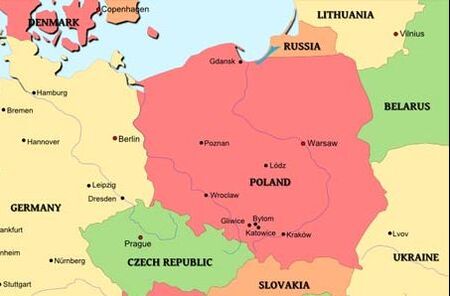
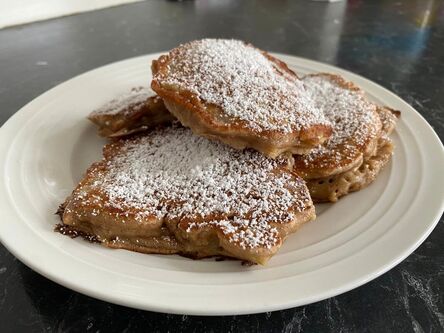


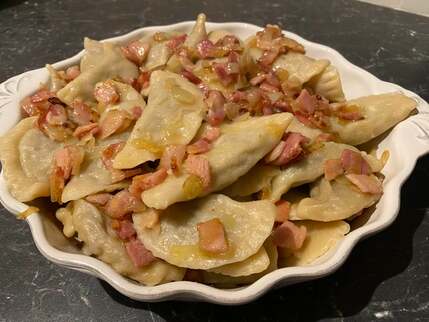


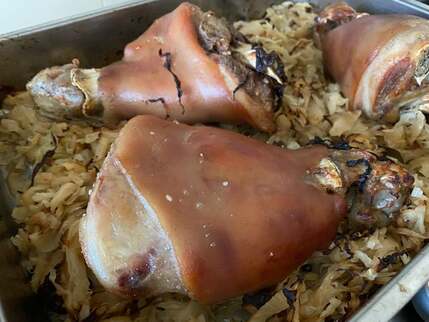
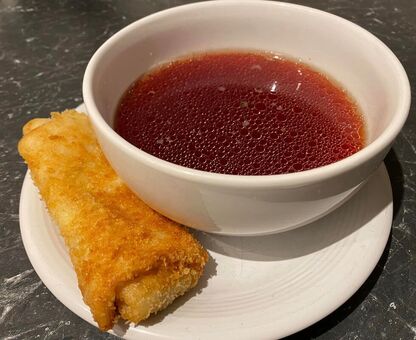



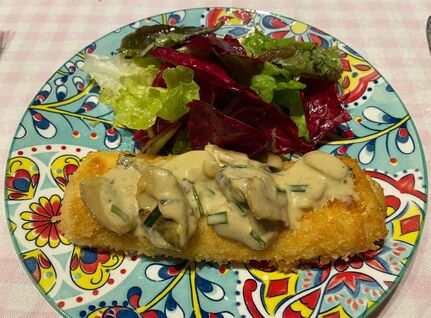
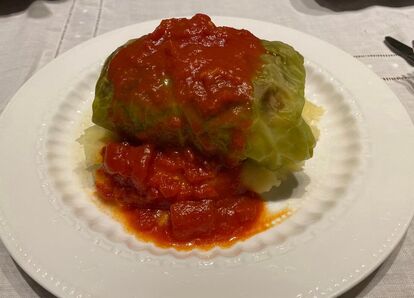
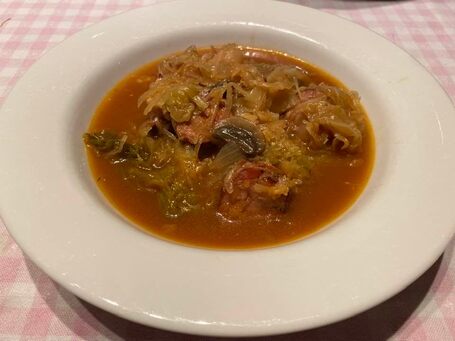


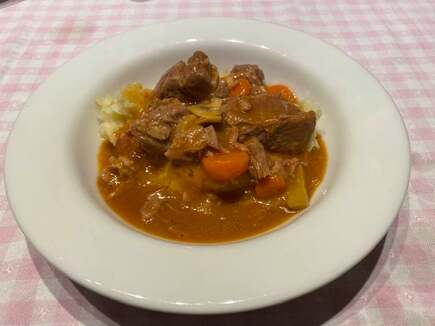
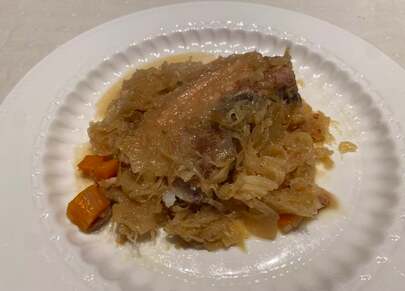



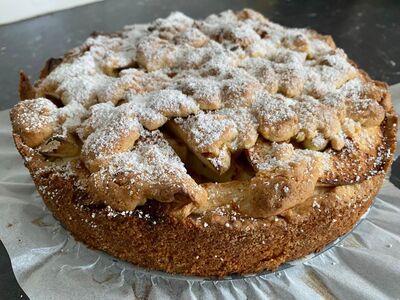
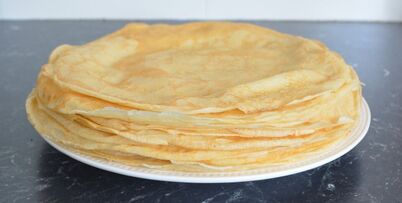

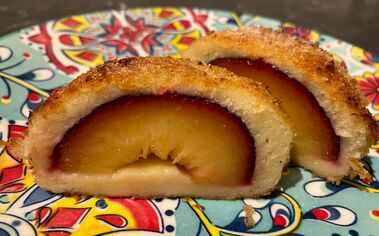
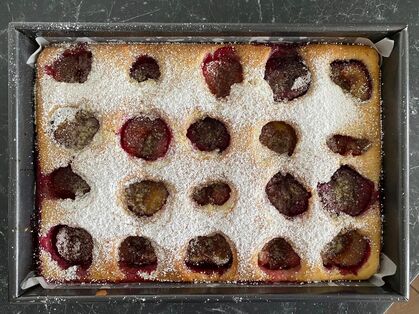
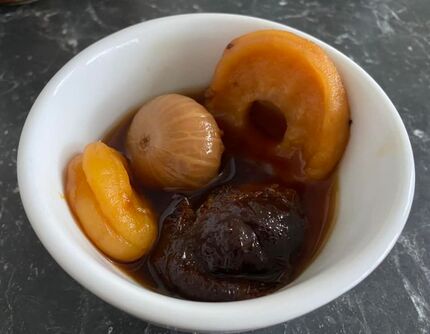

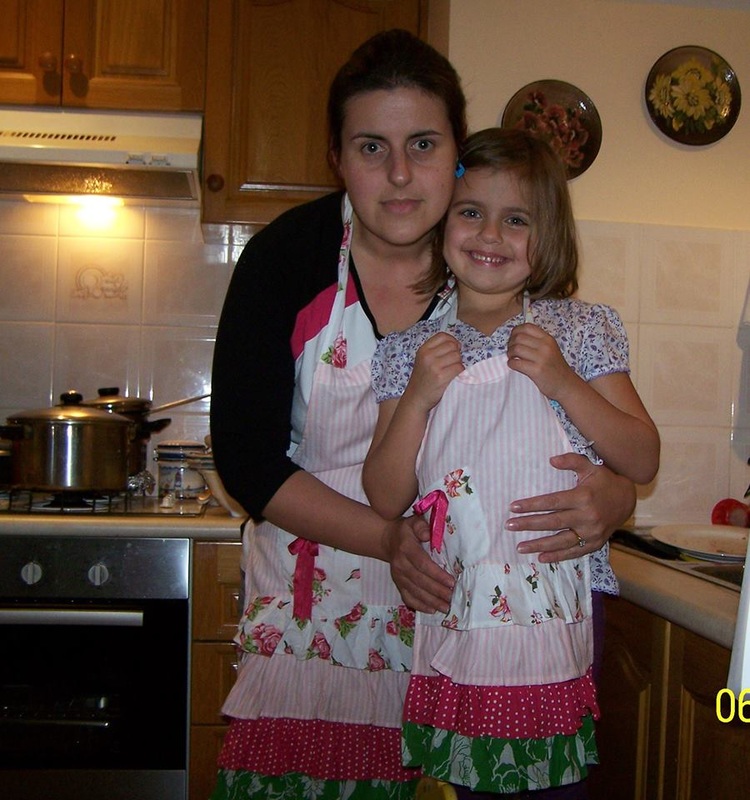
 RSS Feed
RSS Feed